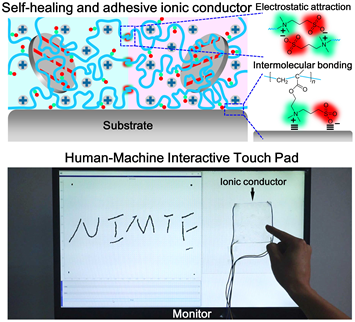A research group led by Prof. Chen Tao at the Ningbo Institute of Materials Technology and Engineering (NIMTE) of the Chinese Academy of Sciences (CAS), developed a novel soft self-healing and adhesive human-machine interactive touch pad based on transparent nanocomposite hydrogels, in cooperation with researchers at the Beijing Institute of Nanoenergy and Nanosystems (BINN), CAS. The study was published in Advanced Materials.
With the rapid development of information technology and the Internet of things, flexible and wearable electronic devices have attracted increasing interests. A touch pad is a requisite input device for a mobile phone, smart appliance and point-of-information terminal. Indium tin oxide (ITO) has been used as the dominant transparent conductive film for manufacturing commercial touch pads, which inevitably have obvious shortcomings, like fragility.
To improve the stretchability and biocompatibility of touch pads to allow their interaction with humans, the researchers at NIMTE developed highly transparent and stretchable polyzwitterion-clay nanocomposite hydrogels with transmittance of 98.8 % and fracture strain beyond 1500 %.
By virtue of the synthesized hydrogel as a transparent ionic conductor, researchers prepared self-healing human-machine interactive touch pads, which are pressure-sensitive adhesive to various curved or flat insulating substrates, including glass, wood, cotton fabric, poly(ethylene terephthalate) (PET), acrylonitrile butadiene styrene (ABS), silicone rubber, nylon, poly(methylmethacrylate) (PMMA), etc. through attach and gentle press, thus satisfying the requirement for the integration into electronic devices and wearable applications.
In addition, a surface-capacitive touch (SCT) system was adopted for the hydrogel touch pad, in which the same voltage was applied to all corners of the pad thus resulting in a uniform electrostatic field across the pad. Therefore, finger position could be perceived through measuring the current value in four corners of the hydrogel, during both point-by-point touch and continuous moving.
Furthermore, hydrogel touch pads were integrated into computers for drawing, writing, and playing electronic games and showed high-resolution and self-healing input functions. The direct current in a cut-then-joint hydrogel recovered in 21 s. Besides, the tensile properties and finger location function of cut-then-joined hydrogels gradually recovered.
The study may shed light on the utilization of polymeric nanocomposite hydrogels as flexible human-machine communication interfaces with the self-healing nature.
This work was supported by the National Natural Science Foundation of China (No. 51773215, 21774138, 61675027, 51622205, 51432005, 61805015, and 61804011), Key Research Program of Frontier Sciences, Chinese Academy of Sciences (No. QYZDB-SSW-SLH036), Youth Innovation Promotion Association of Chinese Academy of Sciences (No. 2019297), Open Research Fund of Key Laboratory of Marine Materials and Related Technologies (No. 2018K02), Beijing City Committee of Science and Technology (No. Z171100002017019 and Z181100004418004), Natural Science Foundation of Beijing Municipality (No. 4181004, 4182080, 4184110, 2184131, and Z180011), National Key R&D project from Minister of Science and Technology, China (No. 2016YFA0202703 and 2016YFA0202704), and Shenzhen Science and Technology Program (Grant No. KQTD20170810105439418).

Fig. The self-healing and adhesive human-machine interactive touch pad with high-resolution input functions demonstrated by writing
Contact
GAO Guorong
Ningbo Institute of Materials Technology and Engineering
E-mail: gaogr@nimte.ac.cn

